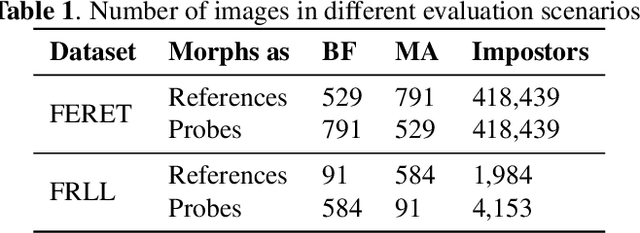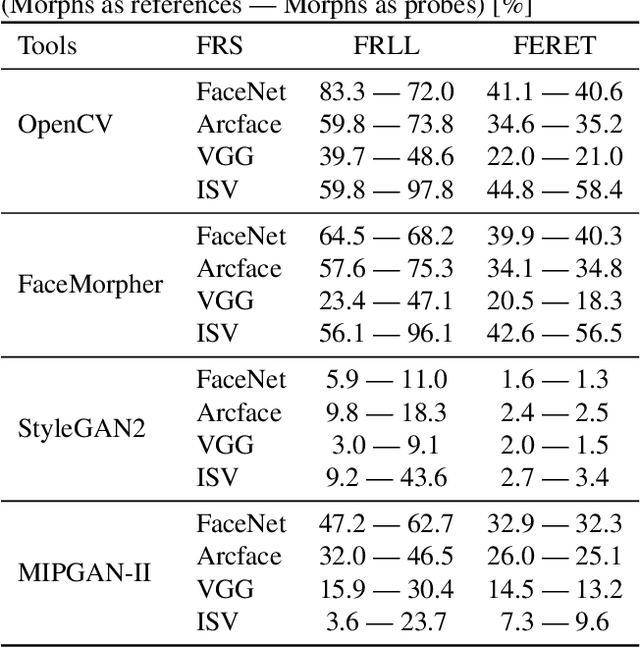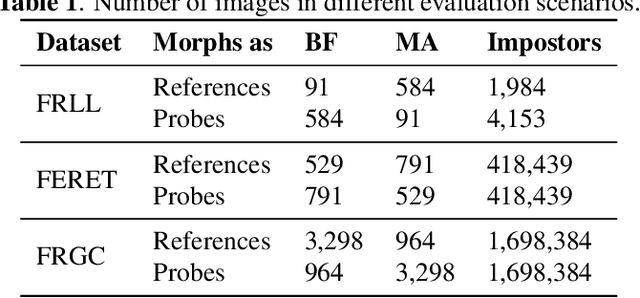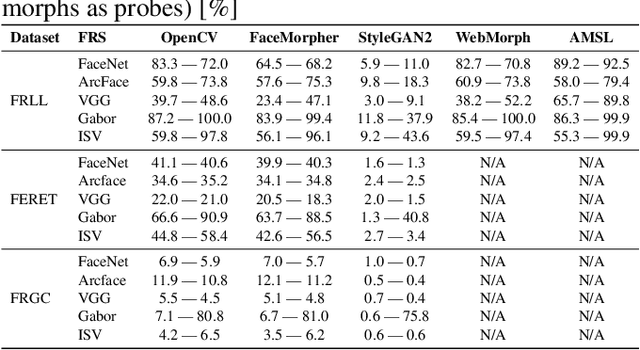Laurent Colbois
Evaluating the Effectiveness of Attack-Agnostic Features for Morphing Attack Detection
Oct 22, 2024



Abstract:Morphing attacks have diversified significantly over the past years, with new methods based on generative adversarial networks (GANs) and diffusion models posing substantial threats to face recognition systems. Recent research has demonstrated the effectiveness of features extracted from large vision models pretrained on bonafide data only (attack-agnostic features) for detecting deep generative images. Building on this, we investigate the potential of these image representations for morphing attack detection (MAD). We develop supervised detectors by training a simple binary linear SVM on the extracted features and one-class detectors by modeling the distribution of bonafide features with a Gaussian Mixture Model (GMM). Our method is evaluated across a comprehensive set of attacks and various scenarios, including generalization to unseen attacks, different source datasets, and print-scan data. Our results indicate that attack-agnostic features can effectively detect morphing attacks, outperforming traditional supervised and one-class detectors from the literature in most scenarios. Additionally, we provide insights into the strengths and limitations of each considered representation and discuss potential future research directions to further enhance the robustness and generalizability of our approach.
Approximating Optimal Morphing Attacks using Template Inversion
Feb 01, 2024Abstract:Recent works have demonstrated the feasibility of inverting face recognition systems, enabling to recover convincing face images using only their embeddings. We leverage such template inversion models to develop a novel type ofdeep morphing attack based on inverting a theoretical optimal morph embedding, which is obtained as an average of the face embeddings of source images. We experiment with two variants of this approach: the first one exploits a fully self-contained embedding-to-image inversion model, while the second leverages the synthesis network of a pretrained StyleGAN network for increased morph realism. We generate morphing attacks from several source datasets and study the effectiveness of those attacks against several face recognition networks. We showcase that our method can compete with and regularly beat the previous state of the art for deep-learning based morph generation in terms of effectiveness, both in white-box and black-box attack scenarios, and is additionally much faster to run. We hope this might facilitate the development of large scale deep morph datasets for training detection models.
Are GAN-based Morphs Threatening Face Recognition?
May 05, 2022


Abstract:Morphing attacks are a threat to biometric systems where the biometric reference in an identity document can be altered. This form of attack presents an important issue in applications relying on identity documents such as border security or access control. Research in generation of face morphs and their detection is developing rapidly, however very few datasets with morphing attacks and open-source detection toolkits are publicly available. This paper bridges this gap by providing two datasets and the corresponding code for four types of morphing attacks: two that rely on facial landmarks based on OpenCV and FaceMorpher, and two that use StyleGAN 2 to generate synthetic morphs. We also conduct extensive experiments to assess the vulnerability of four state-of-the-art face recognition systems, including FaceNet, VGG-Face, ArcFace, and ISV. Surprisingly, the experiments demonstrate that, although visually more appealing, morphs based on StyleGAN 2 do not pose a significant threat to the state to face recognition systems, as these morphs were outmatched by the simple morphs that are based facial landmarks.
* arXiv admin note: substantial text overlap with arXiv:2012.05344
On the use of automatically generated synthetic image datasets for benchmarking face recognition
Jun 08, 2021



Abstract:The availability of large-scale face datasets has been key in the progress of face recognition. However, due to licensing issues or copyright infringement, some datasets are not available anymore (e.g. MS-Celeb-1M). Recent advances in Generative Adversarial Networks (GANs), to synthesize realistic face images, provide a pathway to replace real datasets by synthetic datasets, both to train and benchmark face recognition (FR) systems. The work presented in this paper provides a study on benchmarking FR systems using a synthetic dataset. First, we introduce the proposed methodology to generate a synthetic dataset, without the need for human intervention, by exploiting the latent structure of a StyleGAN2 model with multiple controlled factors of variation. Then, we confirm that (i) the generated synthetic identities are not data subjects from the GAN's training dataset, which is verified on a synthetic dataset with 10K+ identities; (ii) benchmarking results on the synthetic dataset are a good substitution, often providing error rates and system ranking similar to the benchmarking on the real dataset.
Vulnerability Analysis of Face Morphing Attacks from Landmarks and Generative Adversarial Networks
Dec 09, 2020



Abstract:Morphing attacks is a threat to biometric systems where the biometric reference in an identity document can be altered. This form of attack presents an important issue in applications relying on identity documents such as border security or access control. Research in face morphing attack detection is developing rapidly, however very few datasets with several forms of attacks are publicly available. This paper bridges this gap by providing a new dataset with four different types of morphing attacks, based on OpenCV, FaceMorpher, WebMorph and a generative adversarial network (StyleGAN), generated with original face images from three public face datasets. We also conduct extensive experiments to assess the vulnerability of the state-of-the-art face recognition systems, notably FaceNet, VGG-Face, and ArcFace. The experiments demonstrate that VGG-Face, while being less accurate face recognition system compared to FaceNet, is also less vulnerable to morphing attacks. Also, we observed that na\"ive morphs generated with a StyleGAN do not pose a significant threat.
 Add to Chrome
Add to Chrome Add to Firefox
Add to Firefox Add to Edge
Add to Edge